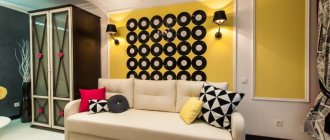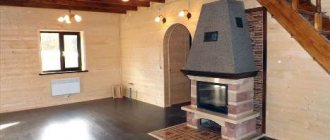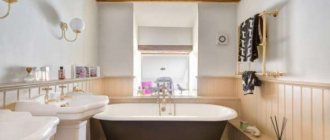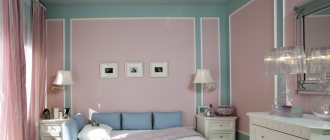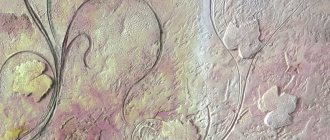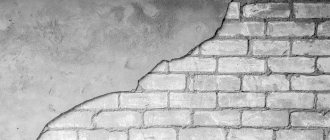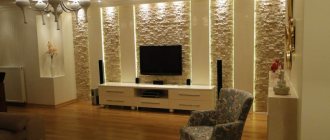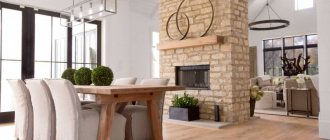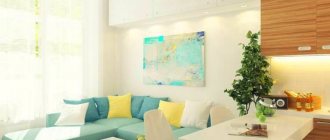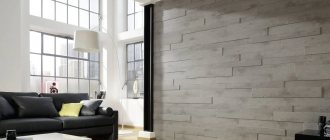Old boards, brick, decorative concrete, gypsum plaster, moss panels - these are just some ideas for decorating walls in the living room. If you already have fairly smooth, painted surfaces, be sure to read our article. We offer options on how to decorate the walls in the living room and how to use selected materials to decorate the interior.
The most important rule: be moderate. If you don't want chaos to creep into your interior, don't combine several completely different materials. You will get a great effect if you select one of the walls and paint the rest in a uniform color. Which wall should I use as an accent wall? Preferably one that is located in a strategic place and involuntarily catches the eye. As a rule, this is the wall in the living room with the TV or the wall behind the sofa. Has the location been found? It's time to choose materials!
Brick on the wall in the living room
Brick is a practical choice because it works with most materials; goes well with wood, stone, glass and steel. In the red version it catches the eye and warms up the interior; in the white version it optically expands the living room and creates a cozy, Scandinavian atmosphere.
If you want to use brick on your living room wall , you have two options - you can show off an old wall or put brick tiles on the wall. The first solution is for people who live in a historic apartment building, former factory building, or other place with history. Once opened, the brick must be carefully cleaned and soaked, but the effect is definitely worth the effort.
Decorating an accent wall
An accent wall is always different in color and texture; its task is to attract attention and visually expand the space of the room.
- The emphasis should be created on the wall that catches your eye first when entering the room.
- In a small room, you can accentuate a part of the wall or a partition.
- Any material different from the main walls is suitable for decoration.
- The color of the accent wall should echo the color of some interior items.
- You can highlight a wall with color, plot, pattern and texture, but you shouldn’t combine everything together.
- When arranging wallpaper, you need to adhere to one quality, combine patterns with plain ones and maintain a balance between a neutral background color and a highlighted bright one.
- Photo wallpaper or painting will add individuality and a cozy atmosphere to the interior.
- When decorated, horizontal stripes will expand the room, while vertical stripes will visually raise the ceilings.
The photo shows an example of interior design in the art deco style, which allows you to combine an abundance of gloss, glass and bright colors in the decoration. Pink 3D panels and a mirror on the accent wall complete the style.
Concrete wall in the living room
The concrete wall in the living room can be made of architectural concrete in the form of ready-made decorative panels. A cheaper, but also effective solution is to use structural paints or plasters, which give the surface a characteristic rough structure and gray color.
Concrete is an elegant and somewhat raw material, so it is worth visually insulating it. To do this, simply introduce a colorful accent into the interior, such as a yellow chair, turquoise pillows, lush green plants (for example, a spreading monstera, fig tree) or natural wood.
Concrete slabs, paints and plasters can brighten up any empty wall, but they will definitely look better than finishing the walls in a TV living room. The large flat screen on the gray rough surface looks ultra-modern and elegant.
Combination of materials
Combination in interior design is an opportunity to highlight one or another area of the room. They combine different materials with each other, or one, but with different decor.
Combining different wallpapers
A variety of decor on the living room wall is stylish and an opportunity to express a non-standard view of the world. Wallpapers are combined in different ways:
- Wallpaper inserts are ideal for decorating empty walls; they are framed with molding.
- Vertical striped combination - alternating two types of wallpaper decor.
- Horizontal - the same principle.
- Patchwork gluing - patchwork style.
Most often this is done above the sofa and TV.
Wall panels and wallpaper
Classic English and French living rooms have wooden wall panels and wallpaper in their wall decoration. Below are the corresponding panels. This decision previously made practical sense - wall panels are easier to care for and can be wiped clean to remove dirt. Nowadays, against the backdrop of practical wallpaper, it is more of a tribute to style.
Painting or plaster and panels
The idea is similar to the wallpaper case. The only difference is that the color chosen for both options is often the same. This technique is used to create a not bright design on the wall, but one that matches the chosen style.
Decorating a window in the living room with curtains - design, shape and color.
Look
Living room design with a brick wall: brickwork in the interior of the hall
Look
Wallpaper for the wall in the living room
Wallpaper in the living room can cover the entire wall, from floor to ceiling, or appear in a duet with elegant panels. It is worth taking advantage of its benefits by decorating the wall behind a fashionable sofa, antique chest of drawers or bar counter. Correctly selected wallpaper will direct all attention to the piece of furniture and emphasize its advantages.
The choice of design is an individual matter. Wallpapers featuring large flowers, exotic plant leaves, graphic animals and geometric patterns are on the rise these days. Some of them resemble illustrations from children's books; they are colorful and playful. Others allow you to create a dramatic, theatrical effect in the interior.
For the living room, you can find vinyl wallpaper that is durable and washable, but paper wallpaper is cheaper. When purchasing, you should pay attention to the type of primer, that is, the material from which the bottom layer of the lining was made. The best properties are provided by paper and vinyl wallpapers on a non-woven base, which are much stronger than a thin paper base. To hang wallpaper, just apply glue to the surface of the wall - there is no need to cover it with each tile separately. After soaking, non-woven wallpaper does not swell, stretch or tear, which greatly facilitates its installation and subsequent removal.
Art Nouveau decor
If you try to characterize the modern interior style in a few words, they will certainly be: minimalism, comfort, restraint, sophistication and technology.
Design features
The individuality of the owner, which modern people so strongly want to emphasize, is expressed more in minor details (for example, in bright, extravagant accessories) than in the main idea of the room, where a neutral, restrained background dominates.
- The strict universalism of the Art Nouveau style is combined with a free choice of finishing materials, even the most non-standard ones - cork, laminate, chipboard, glass, stone or plasterboard.
- Flashy saturated colors, overloading the space with things and an incomprehensible blurry overall composition of the room are categorically not welcome.
- Functionality - the emphasis is on the comfortable, convenient and appropriate use of all interior items.
- Accent wall (example: panels made of mirrored metal surfaces - a characteristic feature of the avant-garde style).
Modern style in decorating living room walls
Factors on which the decor of the living room depends
Depending on the size of the living room, certain tricks are used to increase or decrease the space.
In this case, a light palette is used for the walls, and light flowing curtains are selected to match the main color of the room. The central chandelier is complemented with spotlights.
Two more important factors that must be taken into account when selecting finishing materials are the practical functionality of the space and the location of technical communications.
For the loft style, which is not particularly scrupulous in masking communications, plaster of the right shade is sufficient for a complete decor.
Option for decorating living room walls in loft style
Tiles, wallpaper, chipboard panels with patterns imitating natural stone or wood will help to recreate the country style with its calm and comfort.
Walls lined with steel panels with functional inserts and hanging elements are characteristic of a modern style with a high-tech twist.
Photo wallpaper on the living room wall
Photo wallpaper is an interesting alternative to conventional wallpaper. Use them to decorate an entire wall with your favorite photo or graphic. In addition, you can use an extensive database of ready-made designs provided by the selected manufacturer.
The wall painting portfolio is currently based on exotic and animal motifs, large flowers, and all designs that use perspective fun, including shots of narrow streets, corridors or palace interiors. Because a wall mural resembles a huge painting and is a focal point, it looks best on an empty wall, such as behind a sofa.
Installing photo wallpaper on a wall in the living room is not a difficult task. It is enough to arrange the panels in the correct order and glue them to a previously cleaned, smoothed and primed surface. However, a lot depends on the type of material used. For the living room, latex photo wallpapers are most suitable, i.e. printed on latex paper (optionally bonded with laminate), and more expensive, but much more durable non-woven vinyl photo wallpapers.
Wood finish in the living room - wooden wall in the living room
A wooden wall in the living room can be made in many ways. If you like interiors with soul, find old wall boards that owe their beautiful appearance to years of exposure to sun, wind and snow. A similar effect will be provided by stylized, that is, manually processed boards. A cheap solution that provides excellent results is the installation of classic wood panels . It is enough to paint them white or protect them with matte transparent varnish. Finishing the panels done in this way will give the living room a bright and cozy Scandinavian interior.
Be sure to protect the wood with your chosen product before assembly, such as oil or varnish (if the manufacturer has not specified this). Later, regularly clean the wall of dust and dirt, and when it begins to lose its beautiful appearance, renew it. Due to the heavy weight of wooden elements (especially boards), ensure that they are installed correctly and securely on the wall.
Veneered panels for living room walls - veneer finishing
Veneered wall panels look like real wood, but they are definitely cheaper. Only the top layer is made of wood. Because veneers use only a small amount of raw materials, the panels are decorated with expensive and hard-to-find woods such as oak, walnut, mahogany, teak, rosewood and iroko.
In addition to natural veneers, which retain the natural grain pattern, modified veneers are also available. How is it characterized? During the processing process, all wood defects are removed from plywood panels. As a result, the panels have a beautiful, uniform color and regular pattern. Manufacturers also offer various finishing options. Panels for wall cladding in the living room can be protected with an oil or varnish coating, smooth, matte, semi-matte, satin or glossy varnish.
Floor panels for living room walls
A non-obvious, but very interesting solution is to install floor panels on the wall, be it vinyl or laminate . Good quality panels look natural, have a pleasant feel, varied texture and increased abrasion resistance. They stand out from other products at a very attractive price.
Large wooden panels with a light matte finish are suitable for wall decoration in the living room. If you use the same pattern of panels on one wall and on the floor, you will create an effect of interpenetrating planes, which will give the living room interesting depth.
Decoration of the hall: what is the difference between the stylistic solutions
The living room in the house is different from the living room in the apartment. This:
- ceiling height;
- room dimensions;
- illumination – number of windows.
Based on this, designers apply various stylistic solutions:
- Gothic - a lot of light in a large room with high ceilings. On the wall there are vertical elements combined into an arch.
- Byzantine. Wall decoration is carried out in the following variations:
- the entire wall is covered with decorative “rough” plaster. There is a painting in the center;
- a painting by a famous artist is hung on the wall;
- laying gypsum tiles “like brick”;
- plasterboard niches, shelves, built-in cabinets.
The use of lighting is important for shelves and niches.
- Empire style The walls are decorated with arches, columns, and frescoes. A large mirror is a must.
- Modern. The wall does not stand out, but complements the overall picture of the style. Therefore, it is painted in warm colors: pearl gray, blue-gray, light brown, red wine sediment. Textured designs are not used. Occasionally, the wall below is separated by wooden panels.
- High tech. The wall is painted in a “cold” color - gray, lilac with silver, blue, light blue. There is a plasma in the center, with simple style speakers at the bottom or sides. Instead of backlighting from spotlights, there is an LED strip.
- Provence. Light colors, “rough” plaster or “brick-like” gypsum tiles. The wall can be decorated with 2-3 small paintings or sconces.
- Country. Country style requires a bright room. The design uses “calm” tones, wooden panels, and decorative plaster.
- Shabby chic. Color palette – pale pink, blue, white. A plain wall can be diluted with pink flowers and branches. The plasma in the center will be out of place.
If the living room is small, designers combine styles to zone the room - a place to watch TV, drink tea, or study.
Wall panel in the living room
A wall panel in the living room is a solution with many advantages. It not only decorates the interior, but also protects the lower parts of the wall from dirt and damage. As a rule, this happens in combination with paint, but more and more people are combining paneling with patterned wallpaper.
The practical and aesthetic value of the panels is determined by the material from which they are made. A very elegant effect is provided by English panels made from ready-made MDF boards or, in a more expensive version, from natural wood. The smooth varnished surface ensures trouble-free cleaning and easy removal of any dirt. A slightly cheaper, but at the same time practical solution is cladding made from edged wood panels. Painted panels provide a decorative effect without much effort.
Decor options
- The energetic and temperamental atmosphere of the room will be set by glossy paintings with abstract images.
- A panel is suitable for a cozy atmosphere.
- A great idea: decorate a plain wall with artistic photos or black and white family photos in the same frames.
In conclusion, let us remind you: the main feature of the modern style in the decor of the living room remains restrained coldness, and only an accent wall or small heterogeneous inclusions of accessories can enliven the home atmosphere.
Creative decoration of the walls of the living area
Colored posters on a gray wall
Decorating walls with your own hands and improvised means
You can always break this rule by choosing finishing materials in warm pastel colors or by giving preference to natural wood and its imitation.
Plaster on the wall in the living room
Plaster, unlike lining, is purely decorative. It divides the wall surface into smaller segments and diversifies its appearance. When used correctly, it can improve the proportions of the living room, optically raise the ceiling in a low room or lower it if the interior is very high. Elegant plaster is a hallmark of the French style, but it works equally well in modern interiors (creating an interesting contrast with modern decor), glamour, eclectic or New York style.
Living room wall plaster can be made from wood or plaster lamellas that simply adhere to the decorated surface. The planks should create a symmetrical, well-thought-out composition (consisting of rectangles and squares). Plaster will look better if it is painted the same color as the wall.
Photos of interesting ideas
The interior of a living room with snow-white walls is very popular today. He triumphs, pleases the eye, becomes an object of admiration. When looking for ideas on how to decorate white walls, consider the design options below. To prevent this simple, beautiful color from looking boring, it must be correctly positioned in combination with other colors, complemented or diluted by them.
Scandinavian interior
White color has many fans; it is difficult to resist its charm. Many people love Scandinavian natural arrangements, striking in their simplicity and spaciousness. A popular proposal is painted white window frames; furniture makes you look for your own design. How many people, influenced by photographs of Scandinavian design, have made a spontaneous decision to overhaul! Because white, although demanding, easily accepts any creative impulses.
Light walls and bright accents
If lightness is needed, light walls are often chosen. You need to find setting options that help break up the light background a little. You should choose additives in accordance with your own preferences, arrange them starting from the center of the apartment, living room.
Color matching rules must be followed! White is an excellent background for other colors; you can combine any color with it. So that it does not look too dominant, it is better to break it into small parts, spatial forms. Effective additives are suitable:
- colored pillows on the sofa;
- colorful bedspreads;
- colored flower pots;
- vases;
- colorful paintings, posters.
It’s easy to replace a bright object with another if you get tired of it, so the interior can always be changed and updated.
You can combine several colors to create contrasts. In what proportions?
Additives, accessories
Interesting additives will help create a harmonious design.
Stickers, posters. In a child's bedroom, for example, stickers are suitable. Decorated in a similar style and colors, colorful stickers will become a charming detail or a dominant accent. There are many options – characters from fairy tales, animals, plants, geometric shapes, art installations for a teenager’s room.
Photo wallpaper. In children's and adult bedrooms, living rooms, and kitchens, photo wallpapers are popular; thanks to their modern design, they can amazingly transform a room.
White brick wall in Scandinavian and Provence styles. Fans of the Scandinavian style and Provence style can decorate the wall with imitation brick. The rough texture of the brick breaks up the smooth walls.
Wall panels. Decorative wall panels work well. The market offers various models - 3D, made of gypsum composite. You can choose one pattern, creating an intriguing accent on one wall, or cover the entire surface with panels. Stylish accents will be added to the kitchen - a beautiful contrasting glass apron, photo wallpaper, a countertop made of natural or artificial stone
Single colorful details will not destroy the composition and will attract attention. These could be kitchen utensils in your favorite color located in the workspace, elements of light wood, plants, green herbs that refresh the space.
If you need to leave the walls completely white, accents can be added on the floor and ceiling.
Modern living room - light walls, dark floor
A bright carpet and a ceiling painted in intense colors enliven the interior. Properly organized lighting will highlight the atmosphere - spotlights located in many places. Industrial light bulbs in metal cages hanging carelessly on cables and halogen lamps placed in the suspended ceiling will add dynamics to the room.
3d panels on the wall in the living room
3D wall panels are decorative panels with a convex pattern. The surface treated with them acquires an effective three-dimensional structure. Panels can be made from a variety of materials, including lightweight but durable polyurethane, milled MDF, plaster, wood or concrete. 3D panels made of soft polyurethane foam, finished with a pleasant-to-touch velvet-like finish, are becoming increasingly popular. Because they can act as a headboard, they are ideal for finishing the walls behind a sofa.
3D panels on the wall in the living room are more than just decoration. Plates coated with a relief pattern (especially polyurethane) provide additional sound and heat insulation. Their installation is not difficult; the panels are simply glued to a previously cleaned and primed surface. They can be painted, so you can easily match the color to your living room decor.
Wall panels
The main advantages are that there is no need to level the walls; It’s easy to lay communications, you can do additional sound insulation, quick work. The design of walls with wall panels quickly takes on a decorative shape. Not all types are suitable for the living room. But it may be worth excluding cheap PVC panels, fiberboard and MDF.
Modern 3-D panels deserve close attention. With them, the walls receive voluminous and bold decor. But there is no need to cover all 4 walls of the living room with them. They are often used for emphasis, as in the photo.
Wooden oak, walnut or exotic wood panels will emphasize the status of the apartment owners. With them a rich, beautiful atmosphere is guaranteed. This is ideal for English style, French and classical styles.
Panels made from brick or natural stone veneer will bring brutality to the living room. An excellent addition to men's style, as well as for projects in the industrial style, chalets.
Living room design 16 sq.m. How to make it cozy, photo.
Look
Living room design 18 sq.m photo
Look
Wall tiles in the living room
Installing tiles on your living room wall may seem like a bad idea. It's worth giving it a chance. The offer from leading ceramic manufacturers includes modern, extremely elegant designs that are suitable not only for the kitchen or bathroom, but also for the living room. The decor of the living room is in harmony, including with large-format tiles imitating wood, marble or concrete. The material is perfect for wall decoration behind a fireplace or TV.
Decorating the walls located above the sofa
Considering the sofa, we can say that no living room can do without it, so the space above it needs to be filled only with the most necessary things.
If you are a fan of reading, then why not occupy this area with small shelves where you can arrange all your favorite books, which you can sit down and read on a comfortable and soft sofa at any time?
Do you have a lot of books and don’t know how to place them all on the shelves?
So, in addition to the shelves, place two small cabinets near the sofa, which will place the sofa in a “frame”. This picture looks very nice in modern living room styles.
If the living room is in a marine or modern style, then these same shelves can be filled with figurines, shells from the sea or any other souvenirs, vases.
The remaining space can be filled with paintings or family photos.
If you still decide not to hang shelves or install cabinets, then a great idea would be to decorate the same wall (where the sofa is) with contrasting wallpaper.
The size of the wallpaper should match the dimensions of the sofa itself to enhance the effect. Empty space is decorated with empty frames, which will attract the attention of more than one eye.
Moss panels against the wall in the living room
Moss panels create the effect of a living green wall. Although they can be a concern, they are actually very practical and easy to maintain. The panels are made from specially treated and protected moss that does not require maintenance. To enjoy a beautiful green wall for many years, it is enough to fulfill two simple conditions: ensure sufficient humidity in the living room (40-60%) and install the panels in a dark, sunny place away from the fireplace and other heat sources.
Panels with moss on the wall in the living room will be a great addition to a modern or minimalist composition. They will definitely look better in the company of simple, raw materials (including concrete, wood and black steel) and designer furniture.
Decorative plaster
An excellent coating for interior wall decoration is decorative plaster. The special plasticity of the material makes it easy to apply the composition to walls and does not require preliminary preparation of wall panels.
Some types of plaster already contain an antiseptic component, which prevents the development of pathogenic fungus.
Also, the advantages of choosing the material include:
- Wide variety of formulations for use.
- Using a minimal set of tools and your own skill, you can create the most interesting ornaments and reliefs on the surface.
- A long service life is ensured by the universal composition of the plaster.
- Seamless application is an undoubted advantage.
- Fully cured plaster is resistant to mechanical damage.
- The finished coating does not absorb odors, and this is a clear advantage of plaster over wallpaper in combined living rooms.
Thanks to its environmentally friendly composition, the decorative coating does not cause allergic reactions, which should be taken into account by families with children (due to increased allergies).
Stone wall in the living room
Natural stone on the wall in the living room is an exclusive and very expensive solution. However, its price is completely justified. The stone cladding impresses with its durability, unique colors and patterns. With proper care, it can last for tens or even hundreds of years. This is best demonstrated by the historical interiors of churches and palaces.
The enormous wealth of stone cladding allows for a variety of decorative effects. The market includes perfectly smooth polished stone that reflects light like a mirror, rough fired stone, matte stone with a soft-touch matte finish, and densely cut slate. The type of raw material used is equally important. Currently, the most popular tiles are elegant white marble, granite, travertine and sandstone.
Plaster stone on the wall in the living room
Gypsum stone , also called decorative stone , is nothing more than hardened gypsum tiles that imitate sandstone or crushed limestone. What advantages does this material boast? Gypsum tiles look natural, are relatively inexpensive and easy to install, making them an excellent alternative to expensive stone cladding.
The plaster stone on the wall in the living room combines with both modern and traditional compositions. It definitely looks best in interiors decorated in muted, natural colors: black, gray and beige. The exception is gypsum tiles that imitate brick, which are much more versatile. To highlight the decorative texture of the stone, it is worth illuminating the wall with LED lamps, halogen or classic wall lamps.
As you can see, there are plenty of ideas for decorating the walls in the living room. The choice of cladding and wall decorations is so large that there is something for everyone. If you dream of a beautiful, artfully designed interior, be sure to take advantage of one of our offers. Fashionable walls in the living room are the basis for a successful living room arrangement!
Drywall
With the help of drywall, you can not only level walls quickly and inexpensively. Thanks to the ease of its processing, you can create entire compositions - columns, arches, figured ceilings with lighting.
An inexpensive and environmentally friendly material, the disadvantages of which are low strength and the need to attach it to the sheathing, reducing the space in the room, as well as the need for subsequent puttying and painting.
